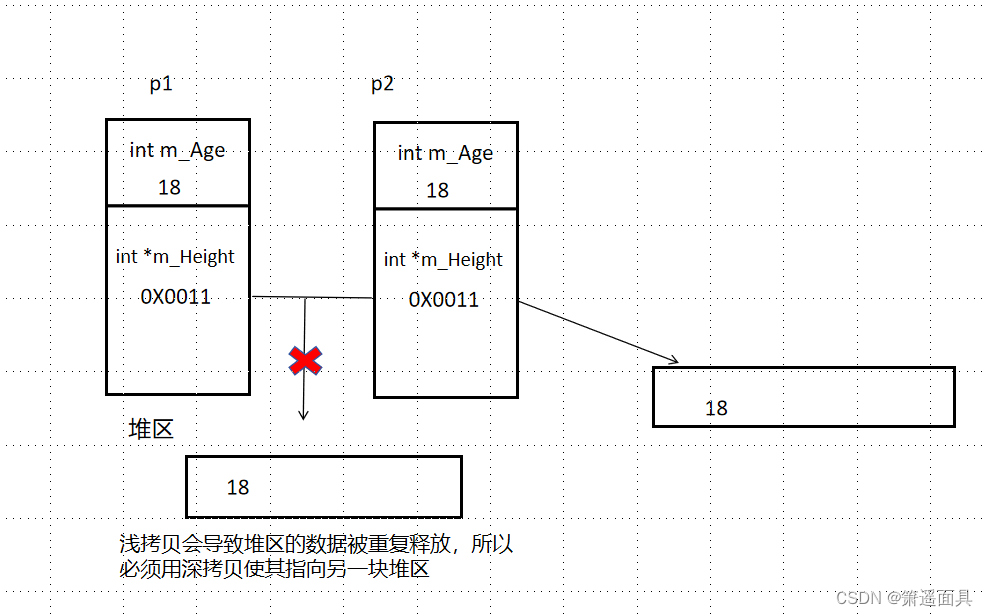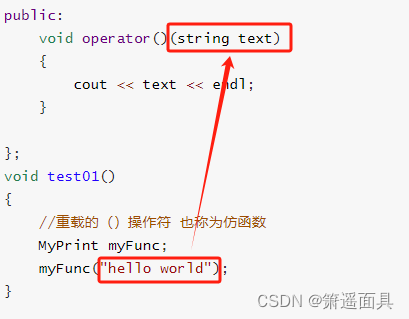4.5.0 运算符重载概念
对已有的运算符重新进行定义,赋予其另一种功能,以适应不同的数据类型,对应的各类型重载如下表所示。
| 成员函数重载(写在类内) | 全局函数重载 | ||
| 加号 | Person operator+(const Person& p) { | Person operator+(const Person& p1, const Person& p2) { | |
| 左移 | 无法实现cout在左侧 | ostream& operator<<(ostream& cout, Person& p) { | |
| 递增 | 前置递增 | MyInteger& operator++() { m_Num++; return *this; }//返回引用,否则无法链式编程 | Person& operator++(Person p) |
| 后置递增 | MyInteger operator++(int) //形参占位区分前后置 { | \ | |
| 赋值 | Person& operator=(Person &p) | ||
| 关系 | bool operator==(Person & p) { if (this->m_Name == p.m_Name && this->m_Age == p.m_Age) { return true; } else { return false; } } | ||
| 函数调用 | void operator()(string text) { cout << text << endl; } | ||
4.5.1 加号运算符重载
作用:实现两个自定义数据类型相加的运算
class Person {
public:
Person() {};
Person(int a, int b)
{
this->m_A = a;
this->m_B = b;
}
//1.成员函数实现 + 号运算符重载
Person operator+(const Person& p) {
Person temp;
temp.m_A = this->m_A + p.m_A;
temp.m_B = this->m_B + p.m_B;
return temp;
}
public:
int m_A;
int m_B;
};
//2.全局函数实现 + 号运算符重载(class+class)
//Person operator+(const Person& p1, const Person& p2) {
// Person temp(0, 0);
// temp.m_A = p1.m_A + p2.m_A;
// temp.m_B = p1.m_B + p2.m_B;
// return temp;
//}
//运算符重载 可以发生函数重载 (class+int)
Person operator+(const Person& p2, int val)
{
Person temp;
temp.m_A = p2.m_A + val;
temp.m_B = p2.m_B + val;
return temp;
}
void test() {
Person p1(10, 10);
Person p2(10, 10);
//成员函数方式
Person p3 = p2 + p1; //成员函数的本质调用 Person p3 = p2.operaor+(p1)
cout << "mA:" << p3.m_A << " mB:" << p3.m_B << endl;
//全局函数方式
Person p4 = p3 + p2; //全局函数的本质调用 Person p4 = operator+(p3,p2)
cout << "mA:" << p4.m_A << " mB:" << p4.m_B << endl;
//全局函数重载
Person p5 = p4 + 10; //全局函数的本质调用 Person p4 = operator+(p4,10)
cout << "mA:" << p5.m_A << " mB:" << p5.m_B << endl;
}
int main() {
test();
system("pause");
return 0;
}总结1:对于内置的数据类型的表达式的的运算符是不可能改变的(int/double等的改变不了)
总结2:不要滥用运算符重载
4.5.2 左移运算符重载
作用:可以输出自定义数据类型
class Person {
friend ostream& operator<<(ostream& out, Person& p);
public:
Person(int a, int b)
{
this->m_A = a;
this->m_B = b;
}
//成员函数:
//成员函数 void operator<<(Person& p)
//实现的是 p.operator<<(p),需要两个对象,有一个对象再传入一个对象(错误的)
//若成员函数为 void operator<<(cout) 简化版本为p << cout
//实现不了 cout<< 不是我们想要的效果
//总结:通常不会用成员函数重载左移运算符(无法实现cout在左侧)
private:
int m_A;
int m_B; //通常写一个类的时候把成员属性设置为私有化,又要让全局函数访问,所以用友元
};
//全局函数实现左移重载
// void operator << (cout , p) 该行代码本质为operator << (cout , p) ,简化为cout<<p
//不知道什么返回类型统一先写void
//ostream(output stream:输出流对象)对象只能有一个,所以用引用的方式(不能创建新的)
ostream& operator<<(ostream& cout, Person& p) {
cout << "a:" << p.m_A << " b:" << p.m_B;
return cout;
}
//输出要继续用链式编程的方法,必须继续返回ostream,调用之后还返回cout才可以继续链式编程
void test() {
Person p1(10, 20);
cout << p1 << "链式编程" << endl; //链式编程
}
int main() {
test();
system("pause");
return 0;
}总结:重载左移运算符配合友元可以实现输出自定义数据类型
4.5.3 递增运算符重载
作用: 通过重载递增运算符,实现自己的整型数据
| 前置递增 | 后置递增 | |
| 返回类型 | 返回引用 (返回值无法链式编程) | 返回值 (返回引用违法操作) |
| 步骤 | 先++再返回(return *this) | 先记录当前值 再++ 再返回原来的值 |
class MyInteger {
friend ostream& operator<<(ostream& out, MyInteger myint);
public:
MyInteger() {
m_Num = 0;
}
//前置++
MyInteger& operator++() {
//返回值也没有错,但是会返回新的值,在新的值上面进行操作,原来的值只会进行第一次操作
//返回值: cout<< ++(++myint) << endl; 输出结果为:2
// cout<< myint << endl; 1(对新对象递增,原对象不变)
//返回引用:cout<< ++(++myint) << endl; 输出结果为:2
// cout<< myint << endl; 2
//先++
m_Num++;
//再返回
return *this; //this指向自身,*this对自身解引用 (返回本身)
//如果返回的是void,语法变成cout << void,仍然不知道返回的是什么,所以依然需要返回int
}
//后置++
//(后置递增返回值不返回引用,若后置返回引用,相当于返回的是一个局部的引用,而局部对象在当前函数执行之后就被释放了,如果再返回引用就是违法操作,所以后置递增一定返回的是值)
MyInteger operator++(int) { //为了发生函数重载必须增加形参int(占位参数,用于区分前置和后置)
//先返回
MyInteger temp = *this; //记录当前本身的值,然后让本身的值加1,但是返回的是以前的值,达到先返回后++;
m_Num++;
return temp; //如果直接return写在前面,函数执行到return就会返回;
}
private:
int m_Num;
};
//重载左移运算符
ostream& operator<<(ostream& cout, MyInteger myint) {
cout << myint.m_Num;
return cout;
}
//前置++ 先++ 再返回
void test01() {
MyInteger myInt;
cout << ++myInt << endl;
cout << myInt << endl;
}
//后置++ 先返回 再++
void test02() {
MyInteger myInt;
cout << myInt++ << endl; //后置递增先输出表达式,再++操作
cout << myInt << endl;
}
int main() {
test01();
//test02();
system("pause");
return 0;
}总结: 前置递增返回引用,后置递增返回值
4.5.4 赋值运算符重载
c++编译器至少给一个类添加4个函数
-
默认构造函数(无参,函数体为空)
-
默认析构函数(无参,函数体为空)
-
默认拷贝构造函数,对属性进行值拷贝
-
赋值运算符 operator=, 对属性进行值拷贝
如果类中有属性指向堆区,做赋值操作时也会出现深浅拷贝问题

class Person
{
public:
Person(int age)
{
//将年龄数据开辟到堆区,用指针维护堆区的数据
//关键字new返回的是一个地址
m_Age = new int(age);
}
//重载赋值运算符 重载运算:p2 = p1,当p2去调用函数时需要传入一个p1,所以要传一个person类
Person& operator=(Person &p)
{
//编译器提供的代码是浅拷贝
//m_Age = p.m_Age;
//深拷贝必须先判断p2本身上面是否有数据,有的话要先置空,再深拷贝
//要把p1的数据都给p1,但是如果p2本身有数据,就会出错
if (m_Age != NULL)
{
delete m_Age;
m_Age = NULL;
}
//提供深拷贝重新new一块空间
m_Age = new int(*p.m_Age); //用自身的指针指向new的新的地址
//返回自身
return *this; //this是指针,需要解引用才能返回本身
//返回值如果是void只能进行一次赋值,如果是p3 = p2 = p1,语法上为p3 = void报错
}
~Person()
{
if (m_Age != NULL)
{
delete m_Age;
m_Age = NULL;
}
}
//年龄的指针
int *m_Age;
};
void test01()
{
Person p1(18);
Person p2(20);
Person p3(30);
p3 = p2 = p1; //赋值操作
cout << "p1的年龄为:" << *p1.m_Age << endl; //p1.m_Age为指针,所以必须解引用
cout << "p2的年龄为:" << *p2.m_Age << endl;
cout << "p3的年龄为:" << *p3.m_Age << endl;
}
int main() {
test01();
//int a = 10;
//int b = 20;
//int c = 30;
//c = b = a;
//cout << "a = " << a << endl;
//cout << "b = " << b << endl;
//cout << "c = " << c << endl;
system("pause");
return 0;
}4.5.5 关系运算符重载
作用:重载关系运算符,可以让两个自定义类型对象进行对比操作
class Person
{
public:
Person(string name, int age)
{
this->m_Name = name;
this->m_Age = age;
};
bool operator==(Person & p)
{
if (this->m_Name == p.m_Name && this->m_Age == p.m_Age)
{
return true;
}
else
{
return false;
}
}
bool operator!=(Person & p)
{
if (this->m_Name == p.m_Name && this->m_Age == p.m_Age)
{
return false;
}
else
{
return true;
}
}
string m_Name;
int m_Age;
};
void test01()
{
//int a = 0;
//int b = 0;
Person a("库里", 18);
Person b("乔丹", 18);
if (a == b)
{
cout << "a和b相等" << endl;
}
else
{
cout << "a和b不相等" << endl;
}
if (a != b)
{
cout << "a和b不相等" << endl;
}
else
{
cout << "a和b相等" << endl;
}
}
int main() {
test01();
system("pause");
return 0;
}4.5.6 函数调用运算符重载
-
函数调用运算符 “()” 也可以重载
-
由于重载后使用的方式非常像函数的调用,因此称为仿函数
-
仿函数没有固定写法,非常灵活

class MyPrint
{
public:
void operator()(string text)
{
cout << text << endl;
}
};
void Print(string text) //函数
{
cout << text << endl;
}
void test01()
{
//重载的()操作符 也称为仿函数
MyPrint myFunc;
myFunc("hello world"); //重载的()操作符:使用的方式非常像函数的调用
Print("hello world"); //函数的调用
}
//仿函数实现非常灵活,实现加法
class MyAdd
{
public:
int operator()(int v1, int v2)
{
return v1 + v2;
}
};
void test02()
{
MyAdd add;
int ret = add(10, 10);
cout << "ret = " << ret << endl;
//匿名对象调用(可以不创建对象直接调用)
//用MyAdd()创建匿名对象,当前行执行完之后立马被释放
cout << "MyAdd()(100,100) = " << MyAdd()(100, 100) << endl;
}
int main() {
test01();
test02();
system("pause");
return 0;
}







 本文详细介绍了C++中的运算符重载,包括加法、左移、递增、赋值、关系和函数调用运算符的重载,以及如何在Person和MyInteger类中实现这些操作,同时讨论了运算符重载的注意事项和应用场景。
本文详细介绍了C++中的运算符重载,包括加法、左移、递增、赋值、关系和函数调用运算符的重载,以及如何在Person和MyInteger类中实现这些操作,同时讨论了运算符重载的注意事项和应用场景。














 245
245











 被折叠的 条评论
为什么被折叠?
被折叠的 条评论
为什么被折叠?








